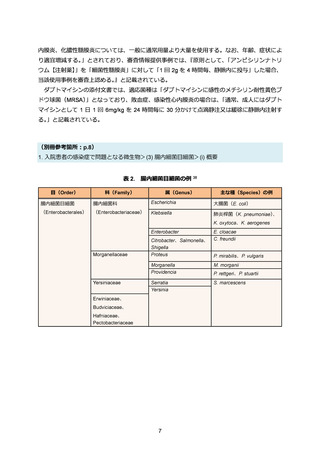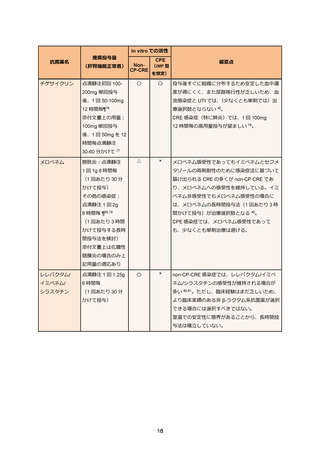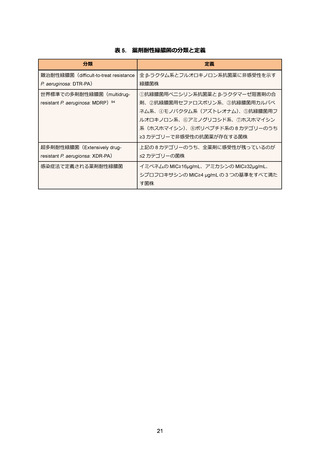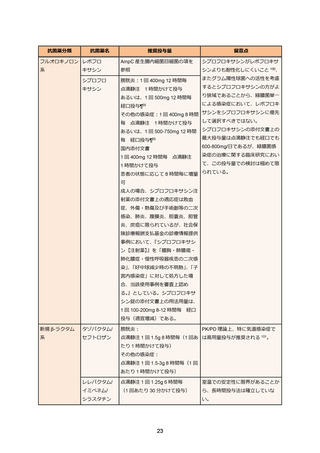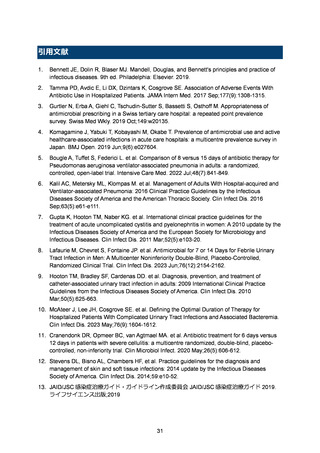よむ、つかう、まなぶ。
【参考資料6】抗微生物薬適正使用の手引き 第三版 補遺 (38 ページ)
出典
| 公開元URL | https://www.mhlw.go.jp/stf/newpage_45318.html |
| 出典情報 | 厚生科学審議会 感染症部会 薬剤耐性(AMR)に関する小委員会 抗微生物薬適正使用(AMS)等に関する作業部会(第6回 11/19)《厚生労働省》 |
ページ画像
ダウンロードした画像を利用する際は「出典情報」を明記してください。
低解像度画像をダウンロード
プレーンテキスト
資料テキストはコンピュータによる自動処理で生成されており、完全に資料と一致しない場合があります。
テキストをコピーしてご利用いただく際は資料と付け合わせてご確認ください。
95. Hong LT, Downes KJ, FakhriRavari A. et al. International consensus recommendations for
the use of prolonged-infusion beta-lactam antibiotics: Endorsed by the American College of
Clinical Pharmacy, British Society for Antimicrobial Chemotherapy, Cystic Fibrosis
Foundation, European Society of Clinical Microbiology and Infectious Diseases, Infectious
Diseases Society of America, Society of Critical Care Medicine, and Society of Infectious
Diseases Pharmacists. Pharmacotherapy. 2023 Aug;43(8):740-777.
96. Lodise TP, Jr., Lomaestro B, Drusano GL. Piperacillin-tazobactam for Pseudomonas
aeruginosa infection: clinical implications of an extended-infusion dosing strategy. Clin Infect
Dis. 2007 Feb;44(3):357-363.
97. Ramsey C, MacGowan AP. A review of the pharmacokinetics and pharmacodynamics of
aztreonam. J Antimicrob Chemother 2016;71:2704-12.
98. Scully BE, Neu HC. Use of aztreonam in the treatment of serious infections due to
multiresistant gram-negative organisms, including Pseudomonas aeruginosa. Am J Med.
1985 Feb;78(2):251-261.
99. Moriyama B, Henning SA, Childs R. et al. High-dose continuous infusion beta-lactam
antibiotics for the treatment of resistant Pseudomonas aeruginosa infections in
immunocompromised patients. Ann Pharmacother. 2010 May;44(5):929-935.
100. Zhao L, Wang S, Li X, He X, Jian L. Development of in vitro resistance to fluoroquinolones in
Pseudomonas aeruginosa. Antimicrob Resist Infect Control. 2020 Aug;9(1):124.
101. Xiao AJ, Miller BW, Huntington JA, Nicolau DP. Ceftolozane/tazobactam
pharmacokinetic/pharmacodynamic-derived dose justification for phase 3 studies in patients
with nosocomial pneumonia. J Clin Pharmacol. 2016 Jan;56(1):56-66.
102. Mensa J, Barberan J, Soriano A. et al. Antibiotic selection in the treatment of acute invasive
infections by Pseudomonas aeruginosa: Guidelines by the Spanish Society of
Chemotherapy. Rev Esp Quimioter. 2018 Feb;31(1):78-100.
103. Kluge RM, Standiford HC, Tatem B. et al. Comparative activity of tobramycin, amikacin, and
gentamicin alone and with carbenicillin against Pseudomonas aeruginosa. Antimicrob Agents
Chemother. 1974 Oct;6(4):442-446.
104. Peleg AY, Seifert H, Paterson DL. Acinetobacter baumannii: emergence of a successful
pathogen. Clin Microbiol Rev. 2008 Jul;21(3):538-582.
105. WHO priority pathogens list for R&D of new antibiotics. 2017. at
https://www.who.int/news/item/27-02-2017-who-publishes-list-of-bacteria-for-which-newantibiotics-are-urgently-needed.)
106. Antimicrobial Resistance C. Global burden of bacterial antimicrobial resistance in 2019: a
systematic analysis. Lancet. 2022 Feb;399(10325):629-655.
107. Gales AC, Seifert H, Gur D, Castanheira M, Jones RN, Sader HS. Antimicrobial Susceptibility
of Acinetobacter calcoaceticus-Acinetobacter baumannii Complex and Stenotrophomonas
maltophilia Clinical Isolates: Results From the SENTRY Antimicrobial Surveillance Program
(1997-2016). Open Forum Infect Dis. 2019 Mar;6(Suppl 1):S34-S46.
108. Hsu L-Y, Apisarnthanarak A, Khan E, Suwantarat N, Ghafur A, Tambyah PA. CarbapenemResistant Acinetobacter baumannii and Enterobacteriaceae in South and Southeast Asia.
Clin Microbiol Rev. 2017 Jan;30(1):1-22.
38
the use of prolonged-infusion beta-lactam antibiotics: Endorsed by the American College of
Clinical Pharmacy, British Society for Antimicrobial Chemotherapy, Cystic Fibrosis
Foundation, European Society of Clinical Microbiology and Infectious Diseases, Infectious
Diseases Society of America, Society of Critical Care Medicine, and Society of Infectious
Diseases Pharmacists. Pharmacotherapy. 2023 Aug;43(8):740-777.
96. Lodise TP, Jr., Lomaestro B, Drusano GL. Piperacillin-tazobactam for Pseudomonas
aeruginosa infection: clinical implications of an extended-infusion dosing strategy. Clin Infect
Dis. 2007 Feb;44(3):357-363.
97. Ramsey C, MacGowan AP. A review of the pharmacokinetics and pharmacodynamics of
aztreonam. J Antimicrob Chemother 2016;71:2704-12.
98. Scully BE, Neu HC. Use of aztreonam in the treatment of serious infections due to
multiresistant gram-negative organisms, including Pseudomonas aeruginosa. Am J Med.
1985 Feb;78(2):251-261.
99. Moriyama B, Henning SA, Childs R. et al. High-dose continuous infusion beta-lactam
antibiotics for the treatment of resistant Pseudomonas aeruginosa infections in
immunocompromised patients. Ann Pharmacother. 2010 May;44(5):929-935.
100. Zhao L, Wang S, Li X, He X, Jian L. Development of in vitro resistance to fluoroquinolones in
Pseudomonas aeruginosa. Antimicrob Resist Infect Control. 2020 Aug;9(1):124.
101. Xiao AJ, Miller BW, Huntington JA, Nicolau DP. Ceftolozane/tazobactam
pharmacokinetic/pharmacodynamic-derived dose justification for phase 3 studies in patients
with nosocomial pneumonia. J Clin Pharmacol. 2016 Jan;56(1):56-66.
102. Mensa J, Barberan J, Soriano A. et al. Antibiotic selection in the treatment of acute invasive
infections by Pseudomonas aeruginosa: Guidelines by the Spanish Society of
Chemotherapy. Rev Esp Quimioter. 2018 Feb;31(1):78-100.
103. Kluge RM, Standiford HC, Tatem B. et al. Comparative activity of tobramycin, amikacin, and
gentamicin alone and with carbenicillin against Pseudomonas aeruginosa. Antimicrob Agents
Chemother. 1974 Oct;6(4):442-446.
104. Peleg AY, Seifert H, Paterson DL. Acinetobacter baumannii: emergence of a successful
pathogen. Clin Microbiol Rev. 2008 Jul;21(3):538-582.
105. WHO priority pathogens list for R&D of new antibiotics. 2017. at
https://www.who.int/news/item/27-02-2017-who-publishes-list-of-bacteria-for-which-newantibiotics-are-urgently-needed.)
106. Antimicrobial Resistance C. Global burden of bacterial antimicrobial resistance in 2019: a
systematic analysis. Lancet. 2022 Feb;399(10325):629-655.
107. Gales AC, Seifert H, Gur D, Castanheira M, Jones RN, Sader HS. Antimicrobial Susceptibility
of Acinetobacter calcoaceticus-Acinetobacter baumannii Complex and Stenotrophomonas
maltophilia Clinical Isolates: Results From the SENTRY Antimicrobial Surveillance Program
(1997-2016). Open Forum Infect Dis. 2019 Mar;6(Suppl 1):S34-S46.
108. Hsu L-Y, Apisarnthanarak A, Khan E, Suwantarat N, Ghafur A, Tambyah PA. CarbapenemResistant Acinetobacter baumannii and Enterobacteriaceae in South and Southeast Asia.
Clin Microbiol Rev. 2017 Jan;30(1):1-22.
38






